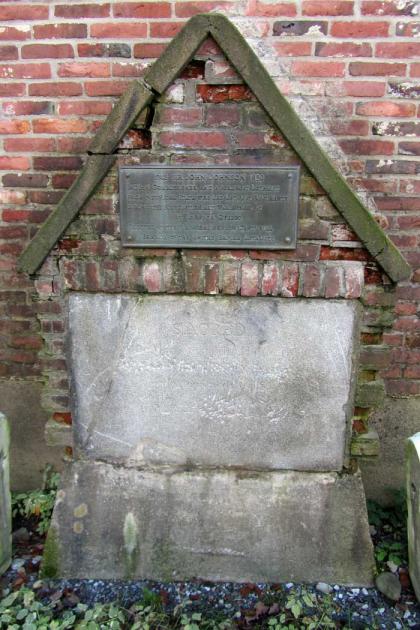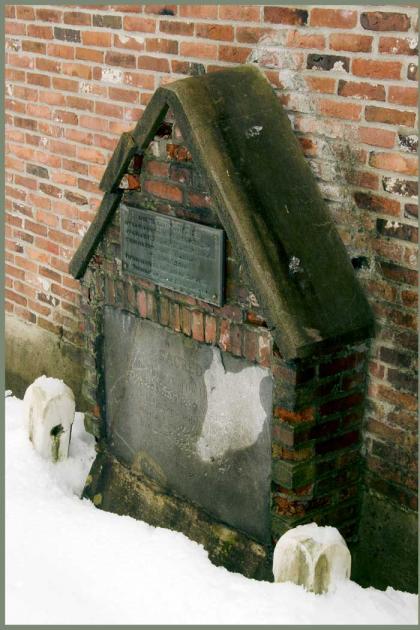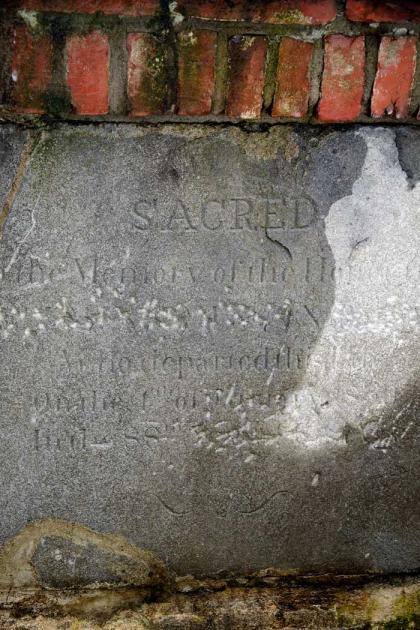Gravestone of Sir John Johnson
Organization: Sir John Johnson Centennial Branch of the United Empire Loyalist Association of Canada
Coordinates: www.uelac.org/SirJohnJohnson
Address: 129 Church Street, Cowansville, QC J2K 1T9
Region: Montérégie
Contact: Michel Racicot, mracicot001(a)sympatico.ca
Description: Gravestone of Sir John Johnson, 2nd Baronet of New York and United Empire Loyalist. Currently located at the Missisquoi Museum, Stanbridge East, QC
Year made: 1830
Made by: Unknown; Sacred to the memory of the Honourable Sir John Johnson who departed this life on the 4th Jan. 1830, aged 88 years
Materials/Medium: Marble
Colours: Grey
Provenance: Probably Montreal or St.-Jean-sur-Richelieu, Quebec
Size: 90 cm x 58.4 cm x 5 cm
Photos: Rachel Garber. Courtesy Missisquoi Historical Society
Gravestone of Sir John Johnson
Michel Racicot
Sir John Johnson, the only son of Sir William Johnson, 1st Baronet of New York, and his wife Mary de Wissenberg, was born in 1742 at Johnstown, in the Mohawk Valley, Province of New York. John Johnson spent most of his childhood at Fort Johnson (near Amsterdam) on the Mohawk River. He received his formal education at home and sporadically at the College and Academy of Philadelphia from 1757 to 1760.
At 13 he had served as a volunteer under the command of his father in the battle against the French at Lake George (Lac Saint-Sacrement) and accompanied him on expeditions to Niagara (near Youngstown, N.Y.) and Detroit. Sir John Johnson was a staunch supporter of the Crown and was contemptuous of anyone who dared disagree with royal policy.
Sir John succeeded to the Baronetcy on the death of his father in 1774, becoming the Second Baronet of New York. When the hostilities erupted in the British colonies, Sir John remained loyal to King George III. During the early years of the American revolution Sir John tried but failed to keep the Mohawk valley loyal to the British cause. In the spring of 1776, Johnson narrowly escaped a military detachment sent to arrest him.
When he arrived in Montreal, Sir John formed the King’s Royal Regiment of New York. A commission dated March 14, 1782, gave Johnson the title of “Superintendent General and Inspector General of the Six Nations Indians and those in the Province of Quebec.” During his long association with the First Nations, he never failed to champion their cause and to demonstrate his concern for their interests and rights. He was, as well, the defender and friend of the loyalists in the province.
When the American Revolution ended, it was Sir John who was assigned the task of settling the Loyalists into their new homes. He organized and supervised the settlement in 1784 of the Loyalists on the upper St. Lawrence and the Bay of Quinte, and by so doing, became the founder of the Province of Ontario. He is considered to be the foremost of the United Empire Loyalists in Canada.
Johnson put a great deal of effort into the acquisition of property. He owned land in Lachine, Montreal, Kingston, Cornwall, and large tracts on Lake St. Francis and the Raisin River, at Gananoque, and on Amherst Island. In 1795 he purchased the seigneury of Monnoir, roughly 84,000 acres, and a few years later the seigneury of Argenteuil, about 54,000 acres.
He built a beautiful manor-house at Mont Sainte-Thérèse on the seigneury Monnoir and renamed the hill Mount Johnson (now known as Mont Saint-Grégoire). He lived there in his senior years.
Sir John died in Montreal in January 1830 at the age of 88. His colourful military and masonic funeral was attended by hundreds of people as well as 300 native supporters. Sir John Johnson was interred in the family vault on Mount Johnson near the village of Saint-Grégoire.
The vault was accidentally bulldozed 60 years ago. Fortunately, Sir John’s gravestone survived, although the wording was badly eroded. In 1967, members of the Sir John Johnson Centennial Branch of the United Empire Loyalist Association of Canada learned of the existence of the tombstone. In November 1968 members of the Branch visited the site at Mont-Saint-Grégoire.
At a meeting of the Branch held during the autumn of 1969, Murray Mason, President of the Branch, reported obtaining the gravestone of Sir John Johnson from Mount Johnson and transporting it to Stanbridge where it was placed at the Missisquoi Museum. The Missisquoi Historical Society granted permission to have the gravestone placed in a niche in the wall. This was done the following year when the new part of the museum was bricked. So the stone, which bears the barely-legible inscription, Sacred to the memory of the Honourable Sir John Johnson who departed this life on the 4th Jan. 1830, aged 88 years, was repaired and installed in the outside wall of the Missisquoi Museum at Stanbridge East, where it remains today. Unfortunately the old stone and the lettering was in such bad condition that re-lettering of the stone was practically impossible to do. It was therefore decided that a plaque would be placed with it. This bronze plaque reads as follows: 1742–1830 – Sir John Johnson – Indian Commissioner and a foremost Loyalist from New York State, who led the Loyalist Regiments during the Revolutionary War. Buried at Mount Johnson, Que. – Erected by the Sir John Johnson Centennial Branch of The United Empire Loyalists.
The Sir John Johnson Centennial Branch is now working to restore the vault, re-inter the remains of Sir Johnson and his family and make the area an historic site to commemorate this important figure in Quebec's history.
Sources
Sir John Johnson, www.biographi.ca
Sir John Johnson – Baronet of the Mohawks, www.uelac.org
The Funeral of Sir John Johnson: Murals in the Grand Lodge of Quebec, www.glquebec.org/murals.shtml
The Loyalists of the Eastern Townships of Quebec, Sir John Johnson Centennial Branch, U.E.L., 1984.
Loyalists in the Eastern Townships, www.uelac.org/SirJohnJohnson/eastern-townships.php
To Learn More
Joseph Bouchette, A topographical dictionary of the province of Lower Canada (London, 1832).
Mary Archibald, “Sir John Johnson, knight of the revolution,” Eleven exiles: accounts of loyalists of the American revolution, ed. P. R. Blakeley and J. N. Grant (Toronto and Charlottetown, 1982.
Author
Michel Racicot is the genealogist for the Sir John Johnson Branch of the UELAC.










Comments
1802 Neptune (ship) setters to Mount Johnston
Hi:
I was wondering if there are any records of the settlers of the Neptune who settled at Mount Johnston presumably shortly after they arrived in 1802? Most left within 20 years I believe. My ancestors were among them.
Thank you in advance for your assistance,
Erin Blair
Hi,
Hi,
You might try contacting the Sir John Johnson Branch of the United Empire Loyalists. Perhaps they can help.
QAHN
Add new comment